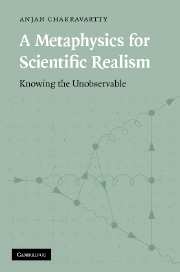Book contents
- Frontmatter
- Dedication
- Contents
- Tables
- Figures
- Preface
- Abbreviations
- Part I Scientific realism today
- Part II Metaphysical foundations
- Chapter 4 Causal realism and causal processes
- Chapter 5 Dispositions, property identity, and laws of nature
- Chapter 6 Sociability: natural and scientific kinds
- Part III Theory meets world
- References
- Index
Chapter 5 - Dispositions, property identity, and laws of nature
Published online by Cambridge University Press: 22 September 2009
- Frontmatter
- Dedication
- Contents
- Tables
- Figures
- Preface
- Abbreviations
- Part I Scientific realism today
- Part II Metaphysical foundations
- Chapter 4 Causal realism and causal processes
- Chapter 5 Dispositions, property identity, and laws of nature
- Chapter 6 Sociability: natural and scientific kinds
- Part III Theory meets world
- References
- Index
Summary
The causal property identity thesis
Causal properties are the fulcrum of semirealism. Their relations compose the concrete structures that are the primary subject matters of a tenable scientific realism. They regularly cohere to form interesting units, and these groupings make up the particulars investigated by the sciences and described by scientific theories. The continuous manifestations of the dispositions they confer constitute the causal processes to which empirical investigations become connected, so as to produce knowledge of the things they study. Scientific realists reach beyond the observable to claim knowledge of certain unobservable properties, structures, and particulars, and by doing so enter the speculative waters of metaphysics. Unlike some metaphysical commitments, being a realist does not require a wetsuit or an oxygen tank, but as I have suggested before, it is not surprising that many realists are not content merely to wade in the shallows. The portrait of realism sketched in Part I places a great deal of weight on certain metaphysical supports, and I have set out to demonstrate the internal coherence of the position by elaborating a unified account of these underpinnings, pointing out along the way certain comparisons to other possibilities with respect to capacities for explanation. Earlier I suggested that the most important aspects of the metaphysical foundations of realism are the idea of causation and the idea of natural categories of things, or kinds. I began a consideration of these issues by examining the nature of causation.
- Type
- Chapter
- Information
- A Metaphysics for Scientific RealismKnowing the Unobservable, pp. 119 - 150Publisher: Cambridge University PressPrint publication year: 2007



